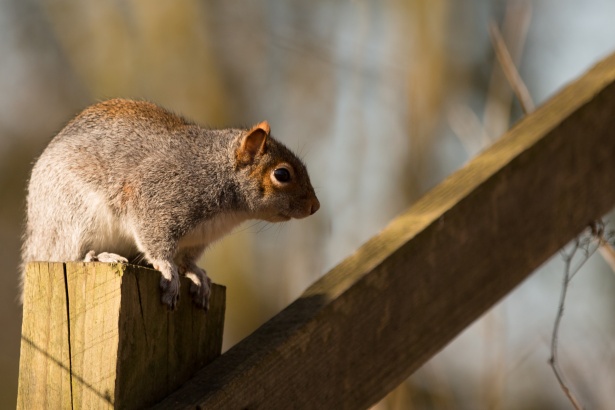
Innocent and playful might be the words you associate with squirrels. But just as these critters can be cute they can also be a menace. Squirrels are usually not harmful when they are living in your trees, but they can be very destructive and a health hazard once they invade your home.
As squirrels have litters of babies twice a year, once in the spring and once in the fall, they are constantly looking for sheltered areas to build their nests. Squirrels get into the attic by chewing holes from the outside, typically above gutters, or at construction gaps where dormers meet the roofline. They may also gain entry to attics by chewing corners of trim or any other weak area that allows them access into the attic space. Attics and soffit areas make ideal nesting location for squirrels. Their height provides protection from predators and humans and allows squirrels to remain warm and dry through inclement cold weather.
Squirrels will commonly cause damage to attic insulation or will chew wires in the attic. Squirrels chew on wires to sharpen, strengthen and control the growth of their teeth. And once they’ve chewed their way through, exposed wires become a major safety concern. Exposed wires can cause unexplained service interruptions, start fires or even electrocute anyone who touches them. As more litters of squirrels are born in or near the home, these squirrels will grow up, leave the nest and search for new areas within the attic to build their own nests. Once inside, their nesting habits and fondness for gnawing down their incisors can cause thousands of dollars in building damage. As long as the squirrels continue to stay in the attics they will try to create more entry points.
Squirrels have also been known to chew through PVC piping. Imagine the destruction that could be caused by a damaged water line in your attic!
Let us look at some incidences where squirrel have severely damaged the attics and which lead to great financial loss
Squirrels are £20 million menace to homeowners
01 Mar 2011, The telegraph
Squirrels have been blamed for causing more than £20 million of damage to homes in Britain, including gnawed roof beams and chewed wiring. Last year, Glen and Laura Borner’s three-bedroom home in Hertfordshire burned down after squirrels chewed through electrical wiring in the loft.
Besides the estimated £20 million of damage to properties, the Forestry Commission said that squirrels also caused more than £10 million.
Flying squirrels and indoor snow make life miserable for Edina condo owner
DECEMBER 12, 2015, Star tribune
When the flying-squirrel guy told Tina Nelson that it was snowing in her attic, she knew things were getting out of hand at her Edina condo.
That was almost two years ago. Since then, the squirrels infesting her attic have been removed and the openings that let them in, along with the snow, have been closed. But Nelson continues to complain of problems with her unit at the Village Homes of Edinborough complex.
Seemingly innocuous attacks by squirrels can cost us dearly in terms of monetary value as well as human life. It is imperative that we take steps to control and contain this damage. Conventional methods of dealing with these creatures include use of toxic chemical additives, trapping. Along the years each of these tried and tested methods have failed at some level due to a variety of reasons including but not restricted to corrosion, adaptability of rodents, development of immunity to traditional poisons, etc.
They play a vital role in our ecosystem. They are great at planting trees. They bury their acorns, but forget where they put them. Hence to use toxic rodenticides to prevent damage caused by squirrels will not be an ideal solution. Also rodenticides can harm target as well as non-targeted species.
The time has come to look for a better alternative; an effective and long lasting solution. A sure shot and effective way of doing this is ensuring that these rodents are kept away from our attics.
A solution involving using the mechanism of repellence will be the best way to go about this as it will mean that the rodents are kept away from the attics in the long run.
RodrepelTM a rodent and animal repellant by C Tech Corporation is ideal.RodrepelTM is a low-toxic, low-hazard rodent repellant available in the form of masterbatch which can be incorporated in the cable sheathing during polymer processing. RodrepelTM in liquid form can be coated on the cable insulation to provide short-term protection from rodents. RodrepelTM lacquer can be applied as a topical application on the attics and also on the already installed cables. This product has been engineered with precision to work on multiple levels targeting the acutely developed sense of the rodents. It also targets the other olfactory senses causing temporary discomfort ensuring the rodent stays away from the end application.
Our newly developed products, Rodrepel™ Rodent Repellent Spray is an easy to use product which can be sprayed on wires and cables, electronic appliances, cabinets, so as to as avoid the rodents from entering them.
RodrepelTM is cost-effective, inert, and thermally stable and does not degrade on exposure to heat and sunlight. It is RoHS, RoHS2, REACH, NEA, EU BPR, APVMA compliant and FIFRA exempted.
In our war against these four-legged terrorists, Rodrepel™ promises to be a reliable and promising weapon, making it our weapon of choice.
Contact us if you are facing problems against these little critters and also against aggressive animals as well as termites and insects.
Also, visit our websites:
http://www.ctechcorporation.com/
http://www.rodrepel.com/
http://www.termirepel.com/
http://www.combirepel.com/
Follow our Facebook pages at:
1] https://www.facebook.com/Combirepel-411710912249274/
2] https://www.facebook.com/Termirepel-104225413091251/
3] https://www.facebook.com/Rodrepel-120734974768048/
Follow us on our Twitter pages at:
1] https://twitter.com/rodrepel
2] https://twitter.com/termirepel
3] https://twitter.com/combirepel



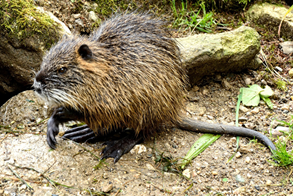 They are back!
They are back!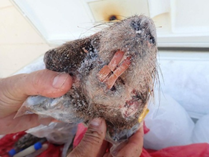 Wearing chest-high waders, biologist Sean McCain tries to tiptoe to the edge of a marsh in California’s Central Valley. A biologist with the state Department of Fish and Wildlife, McCain squints as he searches the shoreline.
Wearing chest-high waders, biologist Sean McCain tries to tiptoe to the edge of a marsh in California’s Central Valley. A biologist with the state Department of Fish and Wildlife, McCain squints as he searches the shoreline.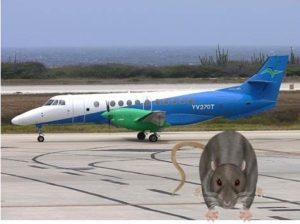 Aviation is one of the most ‘global’ industries: connecting people, cultures and businesses across continents. Aviation has continued to expand. Aviation provides a rapid worldwide transportation network, which makes it essential for global business.
Aviation is one of the most ‘global’ industries: connecting people, cultures and businesses across continents. Aviation has continued to expand. Aviation provides a rapid worldwide transportation network, which makes it essential for global business. Olaf Scholz actually wanted to return home quickly from the IMF meeting in Bali – just in time for the Bavarian election. But the Vice Chancellor’s jet was not ready to go. The reason: damage caused by hungry rodents.
Olaf Scholz actually wanted to return home quickly from the IMF meeting in Bali – just in time for the Bavarian election. But the Vice Chancellor’s jet was not ready to go. The reason: damage caused by hungry rodents. You might be thinking, “Mice are tiny! How could they cause so much damage? The same can be said for rats, squirrels and other rodents. Don’t let appearances fool you. Mice and other rodents might seem sweet and innocent, but the reality is the damage they can do to your home can be significant and costly.
You might be thinking, “Mice are tiny! How could they cause so much damage? The same can be said for rats, squirrels and other rodents. Don’t let appearances fool you. Mice and other rodents might seem sweet and innocent, but the reality is the damage they can do to your home can be significant and costly.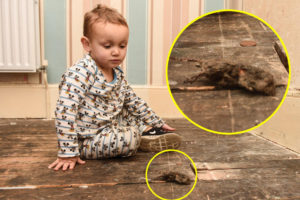 Carla Hazlett, 41, claims they have chewed her possessions and left droppings and urine all over her children’s clothes.
Carla Hazlett, 41, claims they have chewed her possessions and left droppings and urine all over her children’s clothes. Who is the culprit for these huge damages?
Who is the culprit for these huge damages?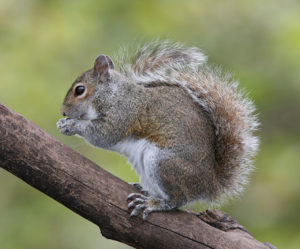 Rodents have a ubiquitous presence and are a nuisance to us. Rodents like squirrels, rats are notorious. They have a pair of incisors which grow throughout their life. Hence to keep them in check they constantly chew on anything they find hard like our wires and cables. They not only damage our wires and cables but they also affect the equipment at the power station.
Rodents have a ubiquitous presence and are a nuisance to us. Rodents like squirrels, rats are notorious. They have a pair of incisors which grow throughout their life. Hence to keep them in check they constantly chew on anything they find hard like our wires and cables. They not only damage our wires and cables but they also affect the equipment at the power station.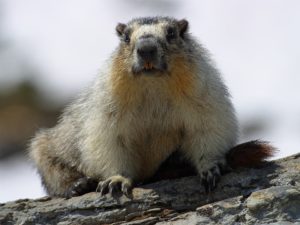 Marmots are large rodents that often become a nuisance to gardeners, farmers, and homeowners due to their appetites and burrowing habits. The yellow-bellied marmot is the most common species in the United States and a close relative of the woodchuck. Also known as rockchucks or whistle pigs, yellow-bellied marmots are social creatures that live in communities of 10 to 20 individuals. During the spring and summer, the animals undergo a period of hyperphagia, a feeding frenzy designed to fatten the marmots so they can survive the coming winter. By huddling together in underground burrows lined with hay or grass, marmots hibernate for up to 200 days at a time, easily spending half of their 13 to 15 years of life asleep.
Marmots are large rodents that often become a nuisance to gardeners, farmers, and homeowners due to their appetites and burrowing habits. The yellow-bellied marmot is the most common species in the United States and a close relative of the woodchuck. Also known as rockchucks or whistle pigs, yellow-bellied marmots are social creatures that live in communities of 10 to 20 individuals. During the spring and summer, the animals undergo a period of hyperphagia, a feeding frenzy designed to fatten the marmots so they can survive the coming winter. By huddling together in underground burrows lined with hay or grass, marmots hibernate for up to 200 days at a time, easily spending half of their 13 to 15 years of life asleep. Rodents are a great threat to farmers as they destroy one percent of the world’s cereal crops on an annual basis. Rodents are the consumers of vitamin and protein-rich foods and often fed on crops embryo, stripping away germination capabilities and nutrients in the process. Rodents are notorious for contaminating food supplies, and one of the primary targets is grains.
Rodents are a great threat to farmers as they destroy one percent of the world’s cereal crops on an annual basis. Rodents are the consumers of vitamin and protein-rich foods and often fed on crops embryo, stripping away germination capabilities and nutrients in the process. Rodents are notorious for contaminating food supplies, and one of the primary targets is grains. Like the above-mentioned cases, there are many cases of rodent attacks on farms causing severe damage to crops and its productivity. Entomologist said 4.6 to 54% paddy crops were lost due to rat infestation. Rodent attack damage as much as 55% of horticultural crops. The extent of stored grain losses depends upon the distribution, abundance, and species composition of the rodent population involved.
Like the above-mentioned cases, there are many cases of rodent attacks on farms causing severe damage to crops and its productivity. Entomologist said 4.6 to 54% paddy crops were lost due to rat infestation. Rodent attack damage as much as 55% of horticultural crops. The extent of stored grain losses depends upon the distribution, abundance, and species composition of the rodent population involved. Swamp rats also known as orange-toothed species, coypu and nutria are the water-loving rodents that inhabit banks of rivers, lakes, lagoons, marshes, and swamps.
Swamp rats also known as orange-toothed species, coypu and nutria are the water-loving rodents that inhabit banks of rivers, lakes, lagoons, marshes, and swamps. Swamp rats breed quickly and the breeding is continuous throughout the year. Besides breeding quickly the Swamp rats consume a large amount of vegetation. They feed yearly on plants including grasses, sedges, reeds, water parsnip, and even water lilies.
Swamp rats breed quickly and the breeding is continuous throughout the year. Besides breeding quickly the Swamp rats consume a large amount of vegetation. They feed yearly on plants including grasses, sedges, reeds, water parsnip, and even water lilies.